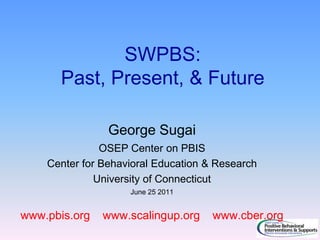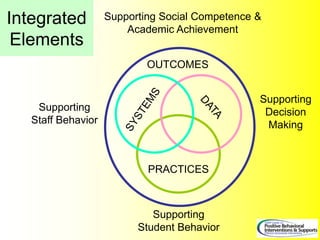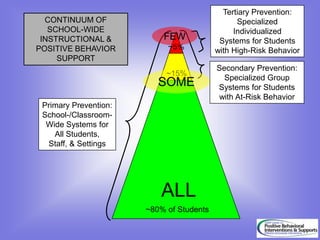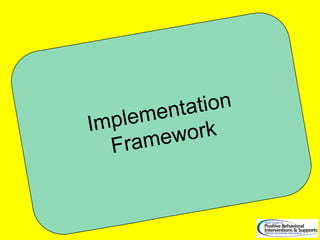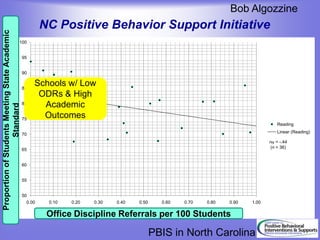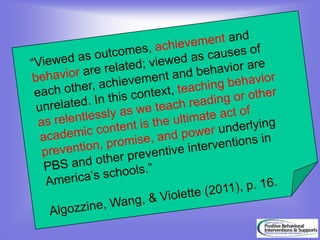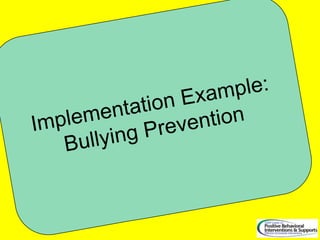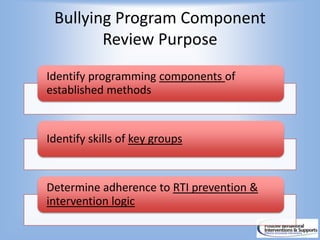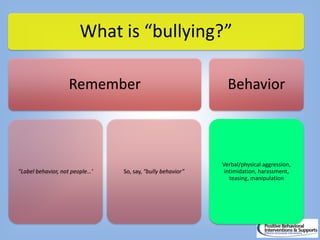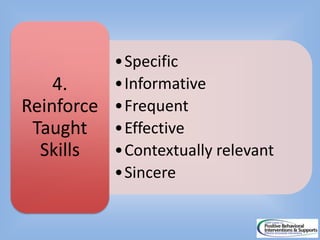Swpbs past present future
- 1. SWPBS: Past, Present, & FutureGeorge SugaiOSEP Center on PBISCenter for Behavioral Education & ResearchUniversity of ConnecticutJune 25 2011www.pbis.org www.scalingup.org www.cber.org
- 2. PURPOSEExamination of current SWPBS practices, systems, & outcomes in context of early influences & future directionsKeynote overview: All
- 3. Follow-up: Administrators, coordinators, coaches, trainers, evaluators
- 4. Coaching: Administrators, coordinators, coaches, trainers, evaluators
- 6. Foundations
- 9. Problem Statement “We give schools strategies & systems for improving practice & outcomes, but implementation is not accurate, consistent, or durable, & desired outcomes aren’t realized. School personnel & teams need more than exposure, practice, & enthusiasm.”
- 11. Special Education & BD
- 14. “Big Ideas” from Early Years
- 15. “Early Triangle”(p. 201)Walker, Knitzer, Reid, et al., CDC
- 16. Guskey, 1986, p. 59
- 17. SWPBS Logic! Successful individual student behavior support is linked to host environments or school climates that are effective, efficient, relevant, durable, scalable, & logical for all students (Zins & Ponti, 1990)
- 18. “BIG PICTURE”
- 19. 12 Basics
- 20. Basics
- 21. 1. Invest in prevention
- 22. Redesign of teaching environments…not students
- 23. 2. Teach, supervise, reinforce
- 24. 2. NATURAL CONTEXT1. SOCIAL SKILLExpectations3. BEHAVIOR EXAMPLES
- 25. 3. Emphasize implementation framework, not curriculum
- 26. SWPBS (aka PBIS/RtI) isFramework
- 27. TeamGENERAL IMPLEMENTATION PROCESS: “Getting Started”AgreementsData-based Action PlanImplementationEvaluation
- 28. 4. Integrate outcome, data, practices, & systems
- 29. IntegratedElementsSupporting Social Competence &Academic AchievementOUTCOMES15SupportingDecisionMakingSupportingStaff BehaviorDATASYSTEMSPRACTICESSupportingStudent Behavior
- 30. 5. Invest in multi-tiered prevention logic
- 31. Tertiary Prevention:Specialized IndividualizedSystems for Students with High-Risk BehaviorCONTINUUM OFSCHOOL-WIDE INSTRUCTIONAL & POSITIVE BEHAVIORSUPPORTFEW~5% Secondary Prevention:Specialized GroupSystems for Students with At-Risk Behavior~15% SOMEPrimary Prevention:School-/Classroom-Wide Systems forAll Students,Staff, & Settings23ALL~80% of Students
- 32. 23Continuum of Support for ALLFewSomeAllDec 7, 2007
- 33. Continuum of Support for ALL“Theora”MathScienceSpanishReadingSoc skillsSoc StudiesBasketballLabel behavior…not peopleDec 7, 2007
- 34. Continuum of Support for ALL:“Molcom”Anger man.Prob Sol.Ind. playAdult rel.Self-assessAttend.Coop playPeer interacLabel behavior…not peopleDec 7, 2007
- 36. 6. Adopt doable implementation “blueprint” or approach
- 40. 7. Embed “Response-to-Intervention” logic & principles
- 41. RtI
- 42. Intensive, Individual InterventionsIndividual Students
- 43. Assessment-based
- 44. High IntensityIntensive, Individual InterventionsIndividual Students
- 45. Assessment-based
- 46. Intense, durable proceduresTargeted Group InterventionsSome students (at-risk)
- 47. High efficiency
- 48. Rapid responseTargeted Group InterventionsSome students (at-risk)
- 49. High efficiency
- 50. Rapid responseUniversal InterventionsAll students
- 51. Preventive, proactiveUniversal InterventionsAll settings, all students
- 52. Preventive, proactiveResponsiveness to InterventionAcademic SystemsBehavioral Systems1-5%1-5%5-10%5-10%80-90%80-90%Circa 1996
- 54. Continuum of Support for ALL“IFB School”LiteracySchool ClimateTechnologyNumeracySocial StudiesWritingAttendanceSpecialsScienceAlign supportsDec 7, 2007
- 55. Continuum of Support for ALL“District: Literacy”Trek E.S.Bianchi M.S.Jamis E.S.Masi H.S.Serrota E.S.Look M.S.Look M.S.Davidson M.S.SpecialsScienceAlign supportsDec 7, 2007
- 56. Teacher Practice Student BehaviorCONTEXTorSETTINGContinua of Responsiveness & SupportDistrict OperationsSchool Reform
- 57. 8. Integrateliteracy & behaviorimplementation & supports
- 58. Elementary School Suspension RatePBIS in Virginia
- 59. Elementary SchoolImprovements in behavior can be associated with improvements in academic outcomesPBIS in Virginia
- 60. Bob AlgozzineNC Positive Behavior Support InitiativeSchools w/ Low ODRs & High Academic OutcomesProportion of Students Meeting State Academic StandardOffice Discipline Referrals per 100 StudentsPBIS in North Carolina
- 61. Academic-Behavior ConnectionAlgozzine, B., Wang, C., & Violette, A. S. (2011). Reexamining the relationship between academic achievement and social behavior. Journal of Positive Behavioral Interventions, 13, 3-16.Burke, M. D., Hagan-Burke, S., & Sugai, G. (2003). The efficacy of function-based interventions for students with learning disabilities who exhibit escape-maintained problem behavior: Preliminary results from a single case study. Learning Disabilities Quarterly, 26, 15-25.McIntosh, K., Chard, D. J., Boland, J. B., & Horner, R. H. (2006). Demonstration of combined efforts in school-wide academic and behavioral systems and incidence of reading and behavior challenges in early elementary grades. Journal of Positive Behavioral Interventions, 8, 146-154.McIntosh, K., Horner, R. H., Chard, D. J., Dickey, C. R., and Braun, D. H. (2008). Reading skills and function of problem behavior in typical school settings. Journal of Special Education, 42, 131-147.Nelson, J. R., Johnson, A., & Marchand-Martella, N. (1996). Effects of direct instruction, cooperative learning, and independent learning practices on the classroom behavior of students with behavioral disorders: A comparative analysis. Journal of Emotional and Behavioral Disorders, 4, 53-62.Wang, C., & Algozzine, B. (2011). Rethinking the relationship between reading and behavior in early elementary school. Journal of Educational Research, 104, 100-109.
- 62. “Viewed as outcomes, achievement and behavior are related; viewed as causes of each other, achievement and behavior are unrelated. In this context, teaching behavior as relentlessly as we teach reading or other academic content is the ultimate act of prevention, promise, and power underlying PBS and other preventive interventions in America’s schools.”Algozzine, Wang, & Violette (2011), p. 16.
- 63. 23Behavior ContinuumAcademic ContinuumRTIIntegrated ContinuumMar 10 2010
- 64. 9. Align professional development & support with implementation phase
- 65. Where are you in implementation process?Adapted from Fixsen & Blase, 2005
- 66. 10. Implement evidence-based practice with fidelity
- 67. Startw/What WorksFocus on FidelityDetrich, Keyworth, & States (2007). J. Evid.-based Prac. in Sch.
- 68. Maximum Student BenefitsFixsen & Blase, 2009
- 69. RCT & Group Design PBIS StudiesBradshaw, C.P., Koth, C.W., Thornton, L.A., & Leaf, P.J. (2009). Altering school climate through school-wide Positive Behavioral Interventions and Supports: Findings from a group-randomized effectiveness trial. Prevention Science, 10(2), 100-115Bradshaw, C.P., Koth, C.W., Bevans, K.B., Ialongo, N., & Leaf, P.J. (2008). The impact of school-wide Positive Behavioral Interventions and Supports (PBIS) on the organizational health of elementary schools. School Psychology Quarterly, 23(4), 462-473.Bradshaw, C. P., Mitchell, M. M., & Leaf, P. J. (2010). Examining the effects of School-Wide Positive Behavioral Interventions and Supports on student outcomes: Results from a randomized controlled effectiveness trial in elementary schools. Journal of Positive Behavior Interventions, 12, 133-148.Bradshaw, C.P., Reinke, W. M., Brown, L. D., Bevans, K.B., & Leaf, P.J. (2008). Implementation of school-wide Positive Behavioral Interventions and Supports (PBIS) in elementary schools: Observations from a randomized trial. Education & Treatment of Children, 31, 1-26.Horner, R., Sugai, G., Smolkowski, K., Eber, L., Nakasato, J., Todd, A., & Esperanza, J., (2009). A randomized, wait-list controlled effectiveness trial assessing school-wide positive behavior support in elementary schools. Journal of Positive Behavior Interventions, 11, 133-145.Horner, R. H., Sugai, G., & Anderson, C. M. (2010). Examining the evidence base for school-wide positive behavior support. Focus on Exceptionality, 42(8), 1-14.
- 70. Reduced major disciplinary infractions
- 71. Improvements in academic achievement
- 72. Enhanced perception of organizational health & safety
- 74. Reductions in teacher reported bullying behavior11. Work smarter by doing a few effective things very well
- 75. Sample Teaming MatrixAre outcomes measurable?
- 77. Evidence-based
- 78. Biggest, durable effectStudent
- 80. ESTABLISHING CONTINUUM of SWPBSTERTIARY PREVENTIONFunction-based support
- 81. Wraparound
- 82. Person-centered planningTERTIARY PREVENTION~5% ~15% SECONDARY PREVENTION Check in/out
- 83. Targeted social skills instruction
- 89. Parent engagementPRIMARY PREVENTION~80% of Students
- 90. 12. Guide decisions with data
- 92. 13. Consider Context & Culture
- 94. 2011+ Basic Big Ideas
- 95. Implementation Example: Bullying Prevention
- 96. Bullying Program Component Review Purpose
- 100. PREVENTIONDe-emphasis on adding consequence for problem behavior
- 101. InitiatorTargetContextorSettingContinuum of Behavior FluencyStaffBystander
- 102. Four basic strategies….if you do nuthin’ else….
- 103. Doesn’t WorkWorksLabel studentExclude studentBlame familyPunish studentAssign restitutionAsk for apologyTeach targeted social skillsReward social skillsTeach allIndividualize for non-responsive behaviorInvest in positive school-wide culture
- 105. www.pbis.org
- 112. 2011+ Basic Big Ideas
Editor's Notes
- “Drowning Frogs”“Green to Yellow to Red” Cards“Full to partial to limited” privileges
- NOTICE GREEN GOES IS FOR “ALL”
- NOTICE GREEN GOES IS FOR “ALL”
- NOTICE GREEN GOES IS FOR “ALL”Baker, 2005 JPBI
- NOTICE GREEN GOES IS FOR “ALL”Baker, 2005 JPBI
- NOTICE GREEN GOES IS FOR “ALL”Baker, 2005 JPBI
- NOTICE GREEN GOES IS FOR “ALL”
- Research to Practice is dependent on good research.
